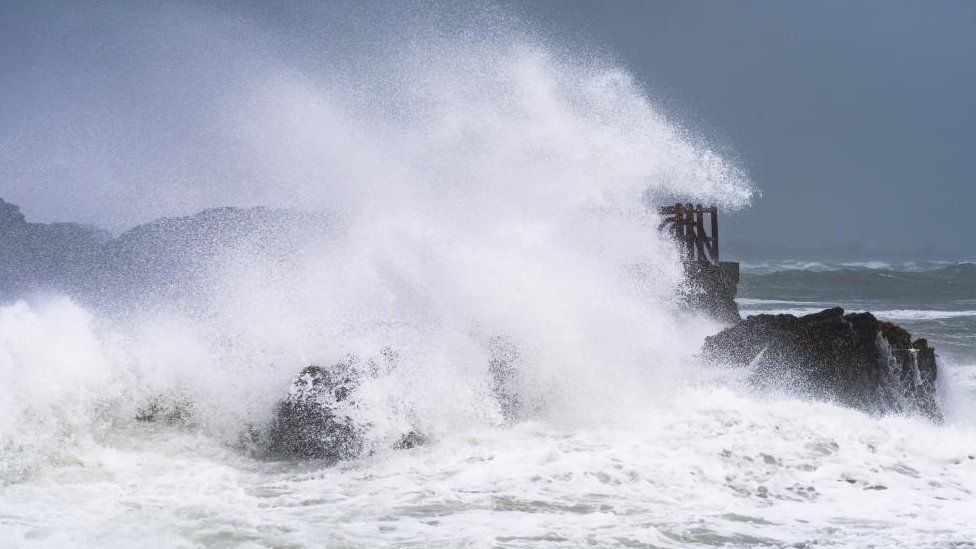
Waves hitting the coast of Dublin during Storm Agnes
By Ruth Comerford
BBC News
Storm Babet is heading for the UK, forecast to bring flooding and strong winds over the next few days.
A yellow weather warning is in place from Wednesday until Saturday – with Scotland in particular braced for 60mph gusts and flooding.
The storm, which arrives less than a month after Storm Agnes barrelled into the UK, is recognised as the second of the 12-month season, which starts in early September.
“Storm Babet will bring impactful rain to many parts of the UK, but especially parts of eastern Scotland, Northern Ireland and northern England later this week,” said the Met Office’s deputy chief meteorologist Steven Keates. “Heavy and persistent rain will fall onto already saturated ground bringing a risk of flooding.”
Why do storms have names?
The practice has long been established in the US, dating back to the 1950s.
The idea was to make it easier for people to engage with weather forecasts, as naming storms and other major weather events makes them more relatable – and easier to discuss and compare over time.
The Met Office in the UK agrees, believing that it is easier to follow the progress of a storm on TV, radio, or social media if it has a name.
Derrick Ryall, from the Met Office, told BBC Newsround: “We have seen how naming storms elsewhere in the world raises awareness of severe weather before it strikes.”
How are storms named?
In 2015, following the success of the US model, the UK Met Office and Irish service Met Éireann launched their first “Name our Storms” campaign.
Most years, they draw the names from a shortlist of favourites submitted by the public. And since 2019, they have been joined by the national weather service of the Netherlands which also chips in a few suggested names each year.
For the 2023/24 season, the Met Office has slightly changed its methods and has named a number of storms after prominent scientists, meteorologists and, in its words, others “who work to keep people safe in times of severe weather”.
In the past, storms have alternated between male and female names but that has altered this year in order to honour the right people.
What names are on this year’s list?
Storm Agnes, which was recognised as the first storm of the season, was named after Agnes Mary Clerke, an Irish astronomer and science writer.
Storm Babet – a name selected by the Dutch weather agency KMNI – was named after a woman who visited an open day at its headquarters and put her own name forward, with the additional reason “because I was born during a storm”.
By the way, if you are wondering, its Dutch origin means the storm name is pronounced Bab-ET (with the stress on the second syllable), rather than Bab-AY, according to the BBC Pronunciation Unit.
The third storm of the year will be named after Ciarán Fearon, who works in the Department for Infrastructure in Northern Ireland.
If we get as far as 10 storms this year, then Dame Jocelyn Bell-Burnell, a leading astrophysicist from Northern Ireland, will have provided the inspiration although she said: “Hopefully they won’t get that far.”
Image source, BBC/Getty Images
Around six to seven named storms impact the UK each year on average, which means names in the second half of the alphabet are put forward but are always unlikely to be used.
And if your name is Queenie or Yasmine, don’t expect to be immortalised as a force of nature. Names beginning with Q, U, X, Y and Z do not even make the shortlist.
And you may hear some names over the coming months which are not on the British/Irish/Dutch list. That is because storms are named where they originate so ones that reach the UK are occasionally the tail end of one that started in the US several days earlier – and may have been downgraded from hurricane or cyclone status.
What makes a storm into a storm?
If your name is on the list don’t get excited and believe that the headwind you find yourself running against in the morning jog means weeks of your name being seen in newspaper headlines and being turned into memes.
Only those “wind events” that are likely to cause significant damage will get a name. That generally is when one of the three weather services believes it has the potential to cause an amber ‘be prepared’ or red ‘take action’ warning.
How do other countries name storms?
Weather agencies in European countries, including Portugal, Spain, Luxembourg, France and Belgium form the south western group that collaborate to name storms. Norway, Sweden and Denmark are a separate northern group.
And for the really big ones, the National Hurricane Centre names tropical storms when they have reached winds of least 40mph, using the six alphabetical lists that are maintained by the World Meterological Organisation. These lists are used on a six-year cycle.
And the undoubted success of the programme of naming storms and hurricanes is underlined by the fact that nobody ever talks about the “hurricane that hit the south-eastern US in August 2005” but the name Hurricane Katrina is universally known and understood.








